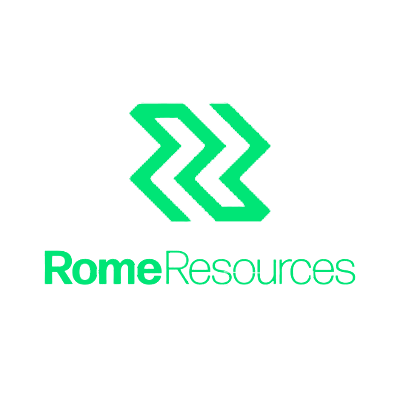Why Rome Resources Offers a Compelling Critical Minerals Investment Opportunity

Rome Resources advances high-grade DRC tin-copper-zinc project toward maiden resource with experienced team, strong markets, September 2025 catalyst ahead.
- Rome Resources operates the Bisie North Tin Project in the Democratic Republic of Congo, targeting high-grade tin, copper, and zinc mineralization in a jurisdiction adjacent to Alphamin Resources' world-class tin operation.
- The company has successfully completed 26 core holes totaling over 5,000 meters across two prospects, with Mont Agoma demonstrating a mineralization zone exceeding 200 meters in width containing tin, copper, zinc, and silver.
- Rome raised £8.2 million before expenses through its July 2024 AIM admission and December 2024 strategic investment, fully funding the current drilling program and maiden resource estimation scheduled for September 2025.
- The tin market faces structural supply constraints while demand is projected to increase up to 40% by 2030, driven by electrification and advanced electronics applications, with LME tin trading at approximately $36,600 per tonne as of November 2025.
- Rome's experienced management team brings over 75 combined years of DRC operational expertise, including direct experience developing the adjacent Alphamin tin mine, providing credible project execution capability.
Rome Resources: Critical Minerals Explorer Advances High-Grade DRC Asset Toward Production
Rome Resources plc has emerged as a focused critical minerals exploration company following its transformational 2024 restructuring, positioning investors to gain exposure to tin, copper, and zinc mineralization in one of Africa's most prospective and historically underexplored mineral belts. Trading on London's AIM market under ticker RMR.L, the company operates the Bisie North Tin Project in the Democratic Republic of Congo's North Kivu province, approximately eight kilometers from Alphamin Resources' Mpama North tin mine, which holds the distinction of processing the highest-grade tin ore globally.
The investment case centers on Rome's systematic delineation of polymetallic mineralization across two distinct prospects: Mont Agoma and Kalayi, both demonstrating grades and geological characteristics analogous to nearby producing operations. With £8.2 million raised and a maiden resource estimation underway for September 2025 completion, Rome offers investors early-stage exposure to critical minerals essential for energy transition technologies, backed by a management team with demonstrated DRC delivery track records.
The broader tin market context strengthens Rome's investment proposition. According to the International Tin Association, global tin demand is forecast to increase by up to 40% by 2030, driven primarily by electrification infrastructure, solar energy systems, electric vehicles, and advanced computing applications. The Massachusetts Institute of Technology identified tin in 2018 as the metal most likely to benefit positively from electrification growth. Meanwhile, supply-side constraints persist, particularly following disruptions in Myanmar and Indonesia, the world's leading producing nations. This supply-demand imbalance supports the current LME tin price of approximately $36,600 per tonne, providing favorable economics for development-stage projects like Bisie North.
Company Overview: Strategic Repositioning Creates Focused Critical Minerals Platform
Rome Resources completed its reverse takeover of Pathfinder Minerals in July 2024, admitting to AIM with £4 million raised before expenses. A subsequent strategic investment in December 2024 provided an additional £4.2 million, establishing the financial foundation for the company's current drilling program. The legacy dispute over Mozambique licenses was settled during this transition period, allowing management to concentrate exclusively on advancing the DRC tin assets.
The company's leadership combines geological expertise with operational experience specific to North Kivu's challenging operating environment. Non-Executive Chairman Klaus Eckhof brings over 20 years of global mineral deposit development experience with a demonstrated DRC delivery track record. Chief Executive Officer Paul Barrett contributes 40 years of resource sector experience across Europe, Russia, Africa, and North America. Chief Operating Officer Mark Gasson provides 39 years of geological experience, including 20 years in the DRC, while Exploration Manager Jamie Anderson worked as Alphamin's Exploration Manager at the adjacent Bisie tin project for seven years, offering direct knowledge of the local geology and operational requirements.
Rome's corporate structure includes three additional non-executive directors with complementary skills in finance, legal, and natural resources. Chief Financial Officer Philip Knowles previously held CFO positions at Firestone Diamonds and Stellar Diamonds, bringing public company financial management expertise. Non-Executive Director Serge Nawej Tshitembu, a Belgian-qualified lawyer and Congolese national, provides specialized knowledge of DRC mining law and regulatory frameworks. This team composition addresses the technical, operational, financial, and jurisdictional requirements for advancing an exploration project toward development in the DRC.
Project Location and Infrastructure: Proximity to Operating Mine Reduces Development Risk
The Bisie North Tin Project occupies an advantageous position within the Walikale mining district of North Kivu province, located approximately eight kilometers from Alphamin Resources' Mpama North underground tin mine. Alphamin's operation, which commenced production in 2019 and is now majority-owned by an Abu Dhabi sovereign wealth fund, processes ore grading approximately 2% tin, exceptional by global standards, demonstrating the district's endowment and commercial viability.
Rome operates with helicopter support from Alphamin's airstrip, maintaining a permanent field camp with full services for approximately 40 staff during active drilling campaigns. The company has established constructive relationships with local communities and artisanal miners, a critical success factor in North Kivu's complex social environment. Sample logistics utilize established routes via Kisangani to Lubumbashi for sample preparation, then to Johannesburg for final assay, leveraging existing mineral transport infrastructure developed for the broader Congolese mining sector.
Recent geopolitical developments may enhance the jurisdiction's investment appeal. A U.S.-brokered agreement signed in early 2025 includes provisions for improved mineral sector access and governance, potentially opening the DRC to expanded international investment. While North Kivu remains a frontier jurisdiction with inherent political and security considerations, Rome's proximity to Alphamin's successful operation and the team's demonstrated local operating capability partially mitigate these risks through proven logistics, community engagement protocols, and regulatory navigation experience.
Mont Agoma: Polymetallic Discovery Demonstrates Scale Potential
Mont Agoma represents Rome's primary exploration focus, where drilling has delineated a mineralized zone exceeding 200 meters in width containing economically significant concentrations of tin, copper, zinc, and silver. The company has completed initial resource drilling and commenced follow-up programs to extend the known mineralization footprint and test depth potential. Geological cross-sections presented in Rome's July 2025 shareholder presentation indicate substantial prospective areas remain undrilled at depth, suggesting resource expansion opportunities.
The polymetallic nature of Mont Agoma provides potential economic advantages through revenue diversification across multiple commodities. Rome's internal preliminary estimates, subject to confirmation through the forthcoming resource estimation, indicate relative metal abundances of approximately 1 part tin, 7 parts copper, and 50 parts zinc by weight. At current commodity prices of approximately $33,000 per tonne tin, $10,000 per tonne copper, and $2,700 per tonne zinc, the company's illustrative relative value calculation suggests zinc may contribute the largest component of potential revenue, with copper second and tin third, despite tin's premium price per unit.
Drilling results announced through June 2025 identified a new northeastern tin zone measuring approximately 40 meters in width, encountered during the second phase resource drilling program. This discovery extends the mineralization envelope beyond initial expectations and prompted limited additional drilling and soil sampling before a planned drilling suspension in August 2025.
Chief Executive Paul Barrett commented on the broader market context:
"The Tin Market is robust with expectations for long term demand growth. Copper and Zinc are also trading well. As we move towards the Maiden Mineral Resource Estimate due for completion next month, we are pleased with progress made. Our ability to advance the project relatively quickly whilst operating in one of the world's more difficult jurisdictions is a testament to the quality of our experienced team both on the ground and in the UK."
The suspension will allow laboratory assays to catch up with sample submission, ensuring complete datasets for incorporation into the maiden resource estimation scheduled for September 2025 completion. Rome has shipped approximately 1,000 kilograms of sample material to Canada for metallurgical and beneficiation testing, a necessary step for understanding mineral processing characteristics and potential recovery rates across the polymetallic assemblage.
Kalayi Prospect: High-Grade Tin Target with Resource Calculation Underway
The Kalayi prospect, located within the broader Bisie North project area, demonstrates high-grade tin mineralization in plunging shoot geometries similar to Alphamin's Mpama South deposit, which currently grades approximately 2% tin. Rome's drilling has covered 600 meters of a 2-kilometer soil geochemical anomaly, defining a well-constrained core area with tin grades reaching commercially attractive levels. The company describes the mineralization style as high-grade plunging shoots, a geological configuration that often produces concentrated, economically robust ore zones when successfully delineated.
A maiden tin resource model for Kalayi is nearing completion as of July 2025, representing a significant near-term catalyst for investment evaluation. Resource estimation transforms geological drilling data into classified mineral inventories according to recognized international standards, typically reported as Inferred, Indicated, and potentially Measured categories depending on drill density and geological confidence. The Kalayi resource will provide the first quantitative assessment of Rome's tin endowment, enabling preliminary economic scoping studies and informing future exploration prioritization.
Significant exploration upside remains at Kalayi, as drilling to date has tested only approximately 30% of the total soil anomaly extent. The northwestern and southeastern extensions represent logical drill targets for future programs, potentially expanding the resource footprint substantially if mineralization continuity is confirmed. This exploration potential, combined with the near-term resource definition catalyst, positions Kalayi as a value driver complementary to the larger but earlier-stage Mont Agoma polymetallic system.
Market Context: Tin Demand Growth Meets Supply Constraints
The tin market's fundamental outlook supports Rome's development timeline. Global tin demand growth projections center on the metal's critical role in electronics manufacturing, where tin-based solder remains irreplaceable for circuit board assembly, and in renewable energy infrastructure, where photovoltaic solar panel production consumes increasing quantities. The energy transition's electrification component, spanning electric vehicle charging networks, grid-scale battery storage, and renewable generation capacity, creates multifaceted tin demand growth across interconnected application areas.
Supply-side dynamics reinforce positive price expectations. The tin market's relatively modest scale, with global refined tin production approximating 350,000 to 400,000 tonnes annually, creates vulnerability to disruptions at individual large-scale operations, each of which can represent 5% or more of global supply. Recent production curtailments in Myanmar, a leading producer, and regulatory uncertainties in Indonesia have contributed to supply tightness. These constraints support the current LME three-month tin price near $36,600 per tonne, substantially above historical averages and providing attractive project economics for new production sources.
Copper, Rome's secondary commodity at Mont Agoma, demonstrates similarly favorable fundamentals. Reuters reported in July 2025 that LME copper was on track to close the first half of the year with a 12% gain, trailing only tin's performance among base metals. Long-term copper demand growth stems from grid electrification, with China's State Grid spending, the world's single largest copper consumer, increasing 25% in early 2025. PricewaterhouseCoopers warned in July 2025 that one-third of global chip production could face copper supply disruptions by 2035, highlighting the structural supply challenge across the electrification value chain.
Operational Progress: Drilling Program Positions Maiden Resource
Rome's operational execution through mid-2025 demonstrates systematic progress toward defining an initial mineral resource. The company has completed 26 core drill holes totaling over 5,000 meters across the Mont Agoma and Kalayi prospects, utilizing three active drilling units operating from the permanent field camp. Core handling facilities on-site include logging, sampling, and X-ray fluorescence analysis, providing preliminary geochemical data before samples are shipped for definitive laboratory analysis.
The drilling campaign has successfully tested the principal mineralized trends at both prospects, providing sufficient drill density for an initial resource estimation while identifying expansion targets for subsequent programs. At Mont Agoma, the discovery of the northeastern tin zone during the second phase drilling exemplifies how systematic exploration can expand the mineralization footprint beyond initial geological models. The decision to suspend drilling in August 2025 reflects disciplined capital allocation, allowing assay backlogs to clear and ensuring maximum data incorporation into the maiden resource calculation rather than accelerating drilling at the expense of resource quality.
Rome's forward program through October 2025 includes completing assays from the current drilling, incorporating metallurgical study results on polymetallic recovery characteristics, and finalizing the maiden resource estimation for release in September. The company has indicated potential for a limited additional drilling program in September, contingent on results from the current campaign, to further delineate the northeastern tin zone at Mont Agoma or test depth extensions. This phased approach balances exploration momentum with financial discipline, allowing resource definition to guide subsequent capital deployment.
Management Expertise: DRC Experience Reduces Execution Risk
Rome's leadership team collectively provides over 75 years of direct Democratic Republic of Congo operational experience, a differentiating factor given the jurisdiction's complexity. Exploration Manager Jamie Anderson's seven-year tenure at Alphamin, including direct involvement in the Bisie tin project's development, offers institutional knowledge of the specific geological setting, local regulatory environment, and community engagement requirements. This experience directly transfers to Rome's adjacent Bisie North project, reducing the learning curve associated with greenfield exploration in challenging jurisdictions.
Chief Operating Officer Mark Gasson's 20 years of DRC experience and service on multiple junior exploration company boards provides operational continuity and governance oversight. Non-Executive Chairman Klaus Eckhof's track record of developing mineral deposits globally, with specific DRC delivery experience, offers strategic guidance for navigating the project through exploration, development decision gates, and potential production scenarios. Non-Executive Director Serge Nawej Tshitembu's expertise in DRC mining law and infrastructure project advisory addresses a critical success factor, regulatory compliance and license security, that has challenged numerous African mining ventures.
The management team's complementary skill sets extend beyond geology and operations. Chief Financial Officer Philip Knowles' experience at publicly traded diamond companies Firestone and Stellar, both of which operated African assets, provides relevant financial management and capital markets expertise. Non-Executive Directors Marc Mathenz and Edouard Etienvre contribute corporate finance, mergers and acquisitions, and natural resources sector investment experience, strengthening Rome's capacity for corporate development transactions, capital raising, and strategic partnership evaluation as the project advances.
Financial Position: Funded Through Resource Definition
Rome Resources' current financial position supports the company's stated operational objectives through the maiden resource estimation milestone. The July 2024 AIM admission raised £4 million before expenses, followed by a £4.2 million strategic investment in December 2024, providing total gross proceeds of £8.2 million. The company's use-of-funds allocation, as presented in shareholder materials, designated approximately 49% for project expenditure, 20% for the reverse takeover transaction, 16% for corporate and administrative expenses, and 16% for working capital.
This capital structure funds the current 5,000-meter drilling program, metallurgical testing, resource estimation consultant fees, and ongoing operational costs through resource definition. The strategic investor's participation at £4.2 million, exceeding the initial AIM admission proceeds, signals institutional confidence in the project's technical merit and management's execution capability. The investment timing, coinciding with the commencement of the second phase drilling program, suggests the capital was deployed to accelerate resource delineation rather than simply maintain operations.
Rome's cash runway through the September 2025 resource release positions the company to define its mineral inventory before requiring additional capital. This financing strategy aligns capital raises with value-inflection milestones, a practice that minimizes shareholder dilution and allows new capital to enter at higher valuations reflecting de-risked projects. The maiden resource will inform subsequent capital requirements for prefeasibility studies, additional drilling, and infrastructure engineering, providing the technical basis for future financing discussions with strategic partners, project finance institutions, or equity markets.
Strategic Significance: Critical Minerals for Energy Transition
Rome Resources' tin, copper, and zinc asset portfolio addresses supply security concerns for minerals designated as critical by multiple Western governments. The European Union, United States, United Kingdom, and Australia all classify tin as a critical mineral due to supply concentration risk, economic importance, and substitution challenges. Copper features on similar lists given its irreplaceable role in electrical applications. This critical mineral designation increasingly influences government policy, including potential offtake support, financing facilitation, and supply chain integration initiatives.
The energy transition's mineral intensity creates structural demand growth across Rome's commodity suite. The International Energy Agency estimates that renewable energy systems require significantly more mineral inputs than fossil fuel equivalents: a solar farm requires five times the mineral intensity of a gas-fired power plant, while an electric vehicle requires six times the mineral content of a conventional automobile. These ratios, multiplied across global decarbonization commitments, translate to substantial demand increases for tin in electronics and solar applications, copper in electrical systems, and zinc in galvanizing renewable infrastructure components.
Geopolitical considerations may further enhance Rome's strategic positioning. Western governments and corporations increasingly seek to diversify mineral supply chains away from concentration in single jurisdictions. While the DRC itself represents concentrated supply for certain commodities, the emergence of multiple operators within the country, including Western-partnered entities, potentially creates diversification within the jurisdiction. The U.S.-brokered agreement referenced in Rome's presentation materials, if successfully implemented, could facilitate increased Western participation in Congolese mineral development, potentially improving access to project finance, offtake agreements, and technical partnerships for companies like Rome.
Investment Thesis for Rome Resources
- Maiden resource estimation scheduled for September 2025 will provide the first quantitative assessment of Rome's mineral endowment, enabling valuation benchmarking against peer companies and supporting preliminary economic analysis.
- Mont Agoma's tin-copper-zinc mineralization offers revenue diversification across three commodities with favorable demand fundamentals, reducing project risk relative to single-metal deposits while potentially enhancing project economics through combined metal revenues.
- Rome's proximity to Alphamin's operating mine and management's demonstrated DRC experience reduce execution risk in a jurisdiction where operational expertise commands premium valuations due to scarcity.
- Current tin and copper prices near cyclical highs, combined with structural demand growth projections, provide attractive entry economics for development projects advancing toward production during this commodity cycle.
- Focused asset base and funded drilling program through resource definition minimize near-term dilution risk, allowing the maiden resource to potentially revalue the company before additional capital requirements.
- Both Mont Agoma and Kalayi demonstrate expansion potential beyond areas covered by current drilling, offering blue-sky exploration upside for investors willing to accept early-stage risk in exchange for discovery potential.
Rome Resources offers investors leveraged exposure to critical minerals essential for energy transition technologies, backed by a management team with demonstrated DRC operational capability and a funded pathway to resource definition. The company's valuation at current trading levels reflects early-exploration stage risk, with the September 2025 maiden resource representing a near-term catalyst that could significantly revalue the equity if mineral inventories meet or exceed market expectations.
The tin market's favorable supply-demand dynamics provide tailwinds for development-stage projects like Bisie North, while copper's structural deficit outlook enhances the polymetallic value proposition. Rome's proximity to Alphamin's world-class operation partially de-risks infrastructure, community, and regulatory factors that have challenged African mining ventures, though investors must still assess DRC jurisdictional risk within their portfolio context.
The investment case centers on resource definition execution and market recognition of Rome's critical minerals portfolio within a favorable commodity price environment. The maiden resource will enable preliminary economic assessment, peer-group valuation comparisons, and strategic partnership discussions, all potential catalysts for share price appreciation if technical results support commercial development scenarios. Investors with appropriate risk tolerance seeking early-stage exposure to electrification-critical metals may find Rome's risk-reward profile compelling at current valuations, recognizing that exploration success remains uncertain and DRC operational risks require ongoing monitoring.
TL;DR
Rome Resources is advancing the Bisie North Tin Project in the Democratic Republic of Congo toward a maiden resource estimation in September 2025, following completion of 26 drill holes delineating tin, copper, and zinc mineralization across two prospects. The company raised £8.2 million in 2024 to fund drilling and resource work, led by a management team with over 75 years combined DRC experience including direct involvement in the adjacent Alphamin tin mine. Tin demand is forecast to grow 40% by 2030 driven by electrification, while current LME prices near $36,600 per tonne support project economics. The maiden resource represents a near-term catalyst that will enable preliminary economic assessment and peer-group valuation, offering early-stage investors leveraged exposure to critical minerals essential for energy transition technologies.
FAQs (AI-Generated)
Analyst's Notes




Subscribe to Our Channel
Stay Informed


















